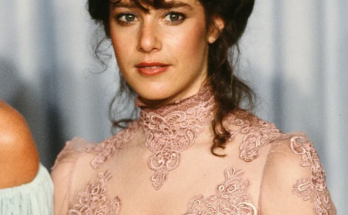The photo was old—yellowed at the edges, curled from time and moisture. It had been tucked between pages of a forgotten family Bible, buried deep in the attic of a farmhouse abandoned for nearly thirty years. A thin layer of dust coated everything. Cobwebs hung like veils from the rafters. But when Ellie found the photo, everything else seemed to disappear.
She wiped it gently with her sleeve, careful not to smudge the fading ink. A woman stared back at her—aged, eyes slightly downcast, yet hauntingly vivid even in black and white. Wrinkles etched deep into her skin told of sorrow, survival, and secrets. Her hair was swept back tightly, revealing sharp cheekbones and a jaw clenched with quiet resolve. She wore no jewelry, no smile, no hint of luxury. Just a plain dress, a hint of lace at the collar, and a gaze that held stories no one had yet told.
Ellie turned the photograph over. Written in faded ink were the words:
“For the record, she waited. —M.A., 1936”
That was all. No name. No date of birth. No clue as to why the photo had been hidden so carefully, so privately. And the woman—the woman with the wrinkles—was unknown to Ellie. Not her mother, not her grandmother. Perhaps a great-aunt? A distant cousin? Or perhaps… someone not related at all?
She brought the photo downstairs and showed her grandmother, now 91 and mostly silent. The old woman held the picture delicately in her arthritic hands and stared at it for a long time. A strange look crossed her face—part recognition, part dread.
“That’s… her,” she whispered.
“Her who?” Ellie asked.
But her grandmother wouldn’t say more. She simply closed her eyes, as though seeing the photo had reopened a door she had long since bolted shut.
Rumors and Whispers
Over the next few weeks, Ellie became obsessed. She scoured the house for more photos, journals, letters—anything that might reveal the identity of the woman. In the basement, behind a pile of rusted tools and broken furniture, she found an old trunk. Inside were bits of lace, faded fabrics, a diary with only three pages filled, and a yellowed envelope sealed with wax.
The diary was cryptic—mentions of “him,” notes about a train that never arrived, and the phrase repeated over and over:
“She waited. Through winter. Through war. Through shame.”
Ellie held her breath. The woman had become more than a mystery; she had become a presence. And as the days passed, Ellie began to feel as though she were being watched. At night, the halls creaked louder than usual. One morning, she awoke to find the photograph placed on her nightstand—though she had locked it in the desk drawer the evening before.
Digging Through History
She visited the county archives, flipping through census records, death certificates, and newspaper clippings. Finally, in a forgotten file from 1937, she found a name.
“Marietta Ashcombe – presumed dead, though no body recovered. Last seen on October 11, 1936, boarding the 5:00 p.m. train to nowhere.”
Train to nowhere? That had to be metaphorical.
Or was it?
According to local stories—which Ellie now began to hear in hushed tones at the diner and churchyard—Marietta was once engaged to a local doctor. He had promised her a life of comfort and family. But on the night before their wedding, he vanished—no letter, no explanation. Some said he fled to Europe. Others said he died in a fire that consumed the old mill by the river.
Marietta never believed he was gone. Every evening at sunset, she walked to the station and waited. Day after day. Year after year. Through gossip, humiliation, even during wartime. She wore the same gray coat. Carried the same handbag. Stared at the tracks until darkness swallowed the sky.
Eventually, she stopped speaking to anyone. When asked how she was, she’d simply reply, “Soon.” Then one day, she, too, was gone.
The Wrinkles Tell Her Story
Ellie returned to the photo again and again. The wrinkles on Marietta’s face—so deep, so etched—were no longer just signs of age. They were time stamps. Each one marked a year she waited. Each crow’s foot whispered of hopes delayed. The lines on her forehead spoke of long, sleepless nights. The faint creases around her lips were not from smiles, but from biting back words that no one would ever hear.
People think photographs capture moments, Ellie thought. But sometimes they capture truths too deep for words.
The Truth Surfaces
Then came a letter.
A man in France had discovered Ellie’s blog post about Marietta. He claimed to be the grandson of Dr. Jonathan Heller—the man who left her. Enclosed in his message was a letter never delivered, written in 1936:
My Dearest Marietta,
I have failed you in a way words cannot repair. War is coming, and I must leave tonight to serve as a medic. I cannot bring shame to you by dragging you into this secret. If I return, I will find you. If I don’t, know that I loved you until the end.
—Jonathan
He never returned. His body was identified in 1944 in northern France.
When Ellie brought this letter to her grandmother, the old woman wept. She confessed that she had once seen Marietta—years after she was presumed dead—living quietly in the woods, tending a small garden by an old chapel. Alone. At peace, but never speaking. “She waited, even then,” her grandmother said. “Even when no one believed.”
Legacy of a Photograph
Ellie had the photo restored and enlarged. She framed it and hung it at the top of the farmhouse stairs, where the light touched it every morning. Visitors would pause before it, some uncomfortable, some curious.
And if they asked, “Who is she?” Ellie would answer:
“She is the woman who waited. The one who kept believing in something when the rest of the world moved on. She is patience. She is sorrow. She is love. And her wrinkles… are the lines of a life fully lived, even in silence.”
In a world that measures worth by noise and speed, Marietta Ashcombe was a whisper. But sometimes, whispers echo longer than shouts.




